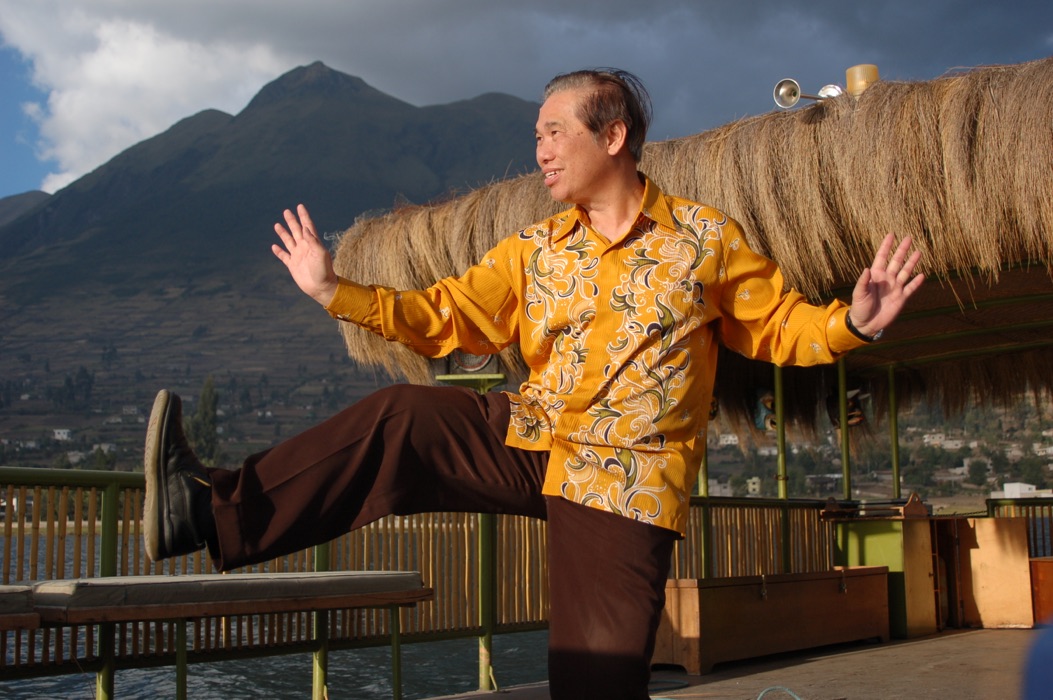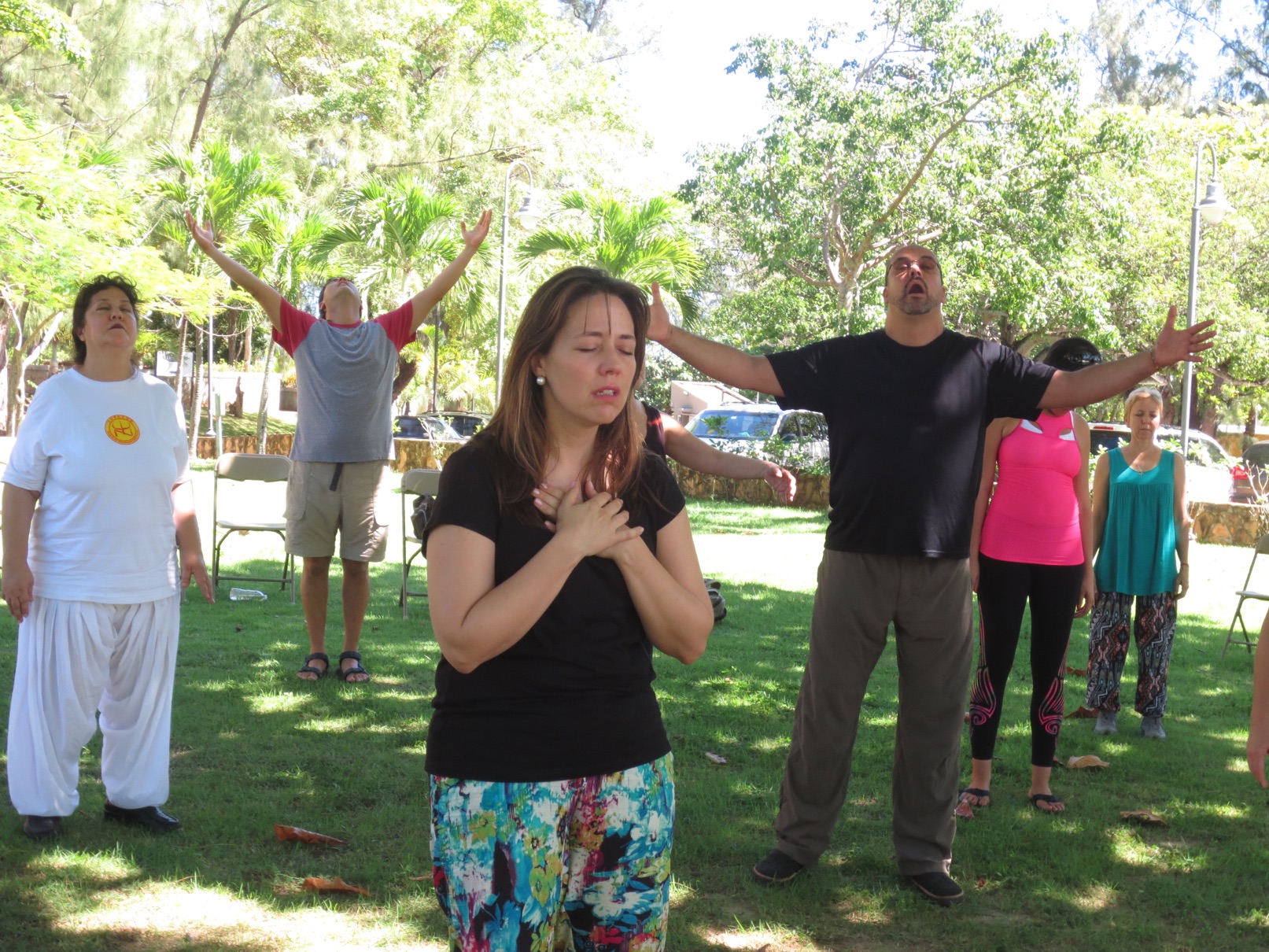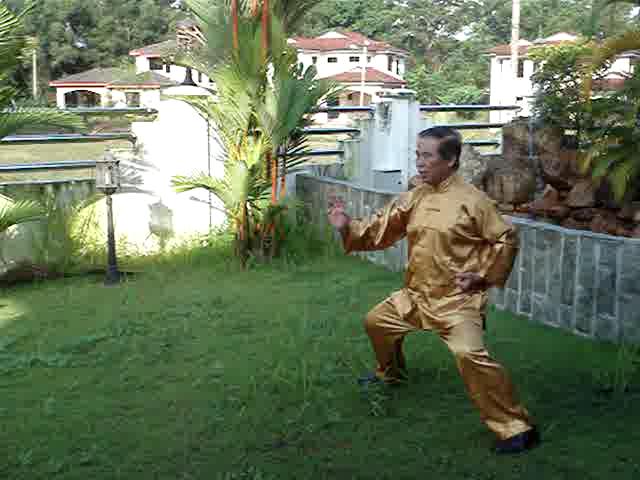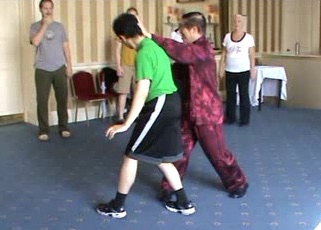SELECTION OF QUESTIONS AND ANSWERS
SEPTEMBER 2016 PART 2

Taijiquan as an internal martial art is different from external Taiji forms as a dance
Question 1
Can we practice Taiji from another school when we learn chi kung from you?
— Micaela, Spain
Answer
Yes, you can.
Whatever you have been doing that brings you benefit or pleasure, you can continue to do so when you learn chi kung from me. For example, you have been practicing Taiji from another school or drinking wine every time you eat your meals, and these activities bring you benefit or pleasure, you can continue to do so.
Whatever you have been doing that brings you harm or displeasure, you can stop doing it after you have practiced chi kung learnt from me for a month. For example, you have been running long distance to keep fit but you don't enjoy doing it, or you have been drinking alcohol excessively and have become addicted, after practicing my chi kung for a month, you just stop running long distance or drinking alcohol.
Later, if you want to run long distance for fun, or drink alcohol with friends and enjoy it, you can do so, and these activities will not harm you after you have practiced chi kung learnt from me. Previously, you ran long distance to keep fit or drank alcohol due to addiction. Now your chi kung practice will keep you fit, and will also erase you addiction to alcohol. If you occasionally perform these activities, it is for fun.
Question 2
You said that a practitioner would take one or two years of correct chi kung practice to feel chi flowing at his skin level. Why do we take only a four-hour course to feel chi flowing at our skin level and then at our muscle level?
Answer
There are three main reasons why our students can attain high level results in a ridiculously short time.
One, we differentiate between techniques and skills. Two, we choose the best techniques for our purpose. Three, I transmit the required skills to the students from heart-to-heart.
Most practitioners, including masters, do not differentiate between techniques and skills. They think that results are due to practicing chi kung techniques diligently. Except for some specific results like building internal force and attaining abdominal breathing, where practitioners may be aware of their special techniques like stance training and dan tian breathing methods, many practitioners merely practice chi kung techniques and the results occur quite haphazardly.
This was my case when I took about 2 years before I could feel chi flowing at my skin level. I just practiced various chi kung techniques taught to me by my sifu, and eventually I experienced the spontaneous result of chi flowing at my skin level. I was amongst the less than 10% of lucky practitioners to have such a result. Most other practitioners do not even have any chi flow.
The most important reason is that I transmit the necessary skills to students from heart to heart so that in a course like Bone Marrow Cleansing Part 1 where such arts are taught, they can attain the desired results within 4 hours. If they practice on their own without my heart-to-heart transmission, even when they differentiate between techniques and skills and choose the best techniques for their purpose, they would need a few months.

There are three main reasons why we are so effective in our chi kung training
Question 3
Sometimes, after a typical day of training, about 10-60 seconds after I went to bed, I went into a kind of chi flow in bed in various manifestations.
Sometimes my body wiould just contort for 5-10 mins, but other times the flow was really strong and my arms and legs moved and flexed very vigorously. For example the chi put me into positions where I was doing headstands or somersaults in bed.
The most powerful and enjoyable was when I sat up in bed and I was really relaxed but I felt tremendous force surging through my arms and legs, and it moved me into a kind of squatting position. The closest I could describe would be like a powerful gorilla.
This felt amazing, and usually lasted for about 5-10 minutes. I always felt wonderful
Is this ok? Should I just enjoy this experience? Should I try to stop it or slow it down? Was it occurring because I practiced well, or I did not practice well? It was always enjoyable during the chi flow.
I wondered whether I was not doing enough chi flow in my actual practise, and that I have stored up either too much chi or internal force for my body, or alternatively caused too much tension in my body and this was chi rectifying by itself.
I have spoken to others who have experienced it, particularly during courses with Sifu.
— Paul, Ireland
Answer
You are right that some people have similar experiences as yours, and my reply here will benefit them.
First I shall answer your series of short questions. Then I shall give a brief explanation of your experience.
Yes, your experience is alright.
Yes, just enjoy the experience.
No, you should not stop it or slow it down.
It occurred because you have practiced well.
Not only your experience is alright, it is an indication that you have very good results from your practice.
If someone practices genuine chi kung correctly, he will feel fresh and energized. But not many people, apart from those in our school, feel fresh and energized after chi kung practice. This is because they do not practice genuine chi kung or they practice wrongly.
Some people may be angry at my statement, "apart from those in our school". As I have mentioned many times, that is their problem, not ours. I am not only stating a fact, more importantly I explain why many chi kung practitioners do not derive the benefits they should get.
The next stage is that when someone practices high-level chi kung (not just genuine chi kung) very well (not just correctly), he will feel more fresh (not just fresh) and greatly energized (not just energized).
The third stage is that these benefits of feeling more fresh and greatly energized occur not just during the time of chi kung practice, but at other times too. This was what happened to you and those Shaolin Wahnam students who had similar experiences.
The fourth stage concerns a lesson I learned when I was still in secondary school. A teacher described that if a person could feel a strong urge to get up from bed at night to perform some exercise, like playing a piano, painting a picture, or performing some chi kung or kungfu movements, not only he had irresistible interest in the art, his accomplishment in the art would also be very great.
You and those who have similar experiences are not at the fourth stage. You are at an even higher stage. At the fuurth stage, the exercise is voluntary. When a person gets up from bed to play a piano, paint a picture or perform chi kung or kungfu movements, he does so physically. You and the others do so in chi flow.
Hence, you should celebrate. When most chi kung practitioners are at the first stage of performing gentle physcial exercise or practicing chi kung wrongly, you are at the fifth stage of feeling more fresh and greatly energized by performing chi kung in a chi kung state of mind.
Question 4
Two-Finger Shooting Zen was the first force training exercise I learnt from you, and it remains very special in my mind.
— Frederick, USA
Answer
Two-Finger Shooting Zen, using the dragon hand-form, was also the first internal force training technique I learned apart form stance training. I learned the patterns "Double Dragons Embrace Moon" and "Double Dragons Emerge From Sea", completing the training with "Double Rolling Thunder" in the Dragon Strength Chi Circulation Set from Uncle Righteousness in 1954, which is more than half a century ago.
At that time I did not know the technique was for internal force training. I just practiced it at a form level -- without any internal force, and also with physical strength. It is like what most people practice kungfu today.
It was after 17 years in 1971 when I learned One-Finger Shooting Zen from Sifu Ho Fatt Nam that I knew how to develop internal force. And only many years later that on highsight I could apply the same skills to develop internal force with Two-Finger Shooting Zen. Indeed, Shaolin Wahnam members are very lucky today that they can develop internal force with its wonderful benefits in daily life on the very first day of their training!

Developing internal force using Two-Finger Shooting Zen
Question 5
I was curious to know what the full set of patterns is for Two-Finger Shooting Zen. In 2012, we learnt just the first section in the Goat Stance, namely Single Planing Flower - Beauty Looks at Mirror - Single Dragon Emerges From Sea - Rolling Thunder Overturns Sky. I also have seen a few different versions.
One version of the Two-Finger Shooting Zen set I saw on some videos had the fourth section finish with Double Dragons Embrace Moon - Double Dragons Emerge From Sea while other videos demonstrate the fourth section being Lower Scissor Hands - Double Worshiping Buddha.
Would you recommend practicing one or the other?
Answer
There is no one special section of internal force training using the dragon hand-form or Two-Finger Zen. You may, if you like, practice a section like One-Finger Shooting Zen, using Two-Finger Zen hand-form instead of the One-Finger Zen hand-form, completing with single tiger-claw or single rolling thunder.
An effective training section is "Single Planing Flower", "Beauty Looks at Mirror ", "Single Dragon Emerges From Sea" and "Rolling Thunder Overturns Sky", like what you have mentioned, as in the Triple Stretch Set and the Flower Set. Here, each hand is practiced separately.
Another effective training section where both hands are practiced at the same time is "Double Dragons Embrace Moon", "Double Dragons Emerge From Sea" and double "Rolling Thunder Overturns Sky" as in the Dragon Strength Set.
The difference is that in the first section, internal force training is focused on one hand at a time. In the second section, it is focused on both hands at the same time. Generally, focusing on one hand at a time is relatively preferable for beginners, but beginners may also focus on both hands at the same time.
Question 6
Is there a particular advantage to training the Double Dragons patterns compared to the Double Worshiping Buddha patterns or vice versa?
Answer
One should attempt Double Worshiping of the Buddha only after he has developed some internal force, using Two-Finger Shooting Zen or One-Finger Shooting Zen. If he starts Double Worshiping of the Buddha afresh, it would take him a much longer time to develop internal force.
This may be an important reason why those who perform Double Worshiping of the Buddha do not have internal force. Most of them merely perform the technique as it is part of a set. They usually do not know its force training and combat application functions.

In Baguazhang Combat Sequence 7 Grandmaster Wong moves to the back of Frederick Chu
Question 7
I was also curious about some aspects of Baguazhang application and force. The Swimming Dragon set in Shaolin Wahnam has half of the combat sequences begin with the combatants' forearms in contact while the other half do not. Is there a particular reason for this situation?
Answer
The two different modes serve different purposes.
When the combatants' arms are in contact, they train sensitivity. When their arms are not in contact, it approximates real fighting situations.
Question 8
I figured that for the seventh Baguashang combat sequence which emphasizes getting to an opponent's back immediately, the contact can train sensing skills for both the initiator to read an opponent's incoming force and to get to their back while the responder learns how to sense an opponent attempting to flank them or get to their back.
Answer
Yes, your observation is correct. When you have developed such abilities, you can still sense your opponents even when your arms are not in contact with theirs.
Editorial Note: Frederick's questions will be continued at the September 2016 Part 3 issue of the Question-Answer Series.
If you have any questions, please e-mail them to Grandmaster Wong via his Secretary at stating your name, country and e-mail address.
LINKS
Selected Reading
- Grasping sparrow's Tail -- Mechanics of Taijiquan Movements
- Chi Kung -- the Art of Developing Energy
- Three Sectional Soft Whip
- Flow Method, force Training and Combat Application
- Beautiful People
